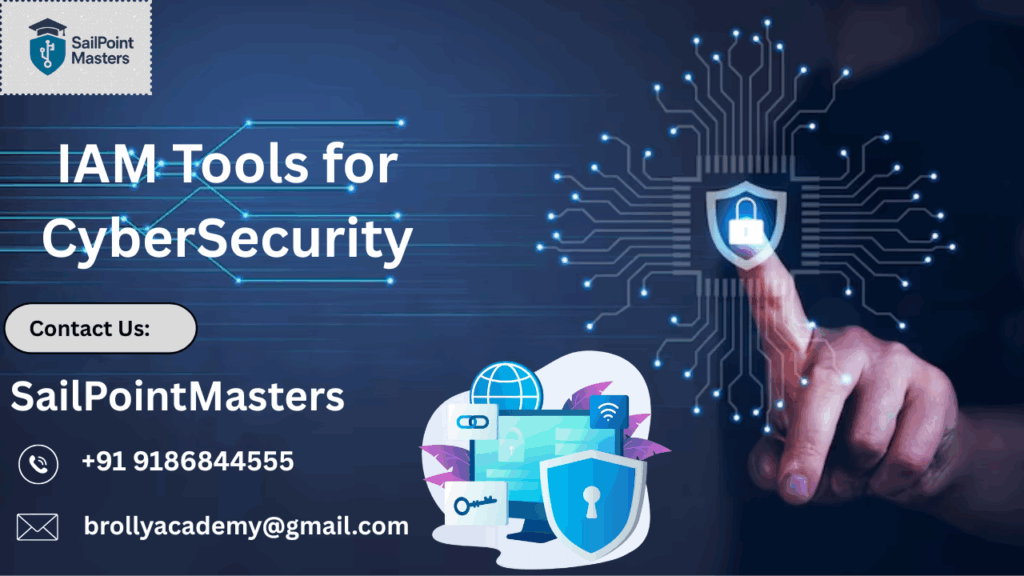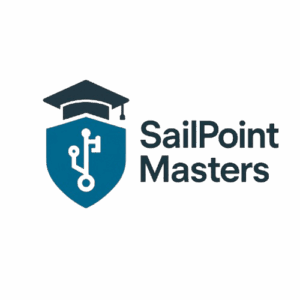Is SailPoint is good for CyberSecurity careers?

Table of Contents
ToggleIs SailPoint good for CyberSecurity Careers?
In today’s digital world, where data breaches, identity thefts, and ransomware attacks are growing more frequent and sophisticated, IAM tools for cybersecurity have become a cornerstone of every organization’s defense strategy. These tools—such as SailPoint, Okta, and CyberArk—not only strengthen access controls but also help businesses stay compliant with regulatory requirements, mitigate insider threats, and streamline identity governance. In 2025, the demand for skilled IAM professionals is surging, driven by the rise of zero trust architectures, hybrid work environments, and strict data privacy laws. Naturally, many aspiring professionals are now asking, “Is SailPoint good for cybersecurity careers?” The answer is a strong yes—SailPoint is one of the most in-demand platforms in the IAM space, offering opportunities across implementation, administration, governance, and cloud security. As organizations prioritize identity-first security strategies, SailPoint expertise can open doors to high-paying, future-proof roles in cybersecurity.
Zero Trust Security Adoption
As more organizations adopt a Zero Trust framework, IAM becomes the core enabler. With Zero Trust, no one—inside or outside the network—is trusted by default. IAM tools ensure strict access controls based on roles, behavior, and policies, making it a fundamental pillar of Zero Trust architecture.
Rise in Remote and Hybrid Workforces
The post-pandemic work culture has made remote access a norm. IAM tools offer secure authentication, role-based access, and identity federation—ensuring that only the right users can access the right resources from anywhere.
Cloud-First and Multi-Cloud Strategies
Modern enterprises operate in multi-cloud environments. IAM solutions such as SailPoint, Okta, and Azure AD provide centralized identity governance and secure access across diverse cloud services—reducing identity sprawl and access mismanagement.
Advanced Threat Protection through AI & Automation
IAM tools now leverage AI and machine learning to detect abnormal access behavior and trigger alerts or automated remediation. This proactive approach is essential to combating sophisticated cyber threats.
Regulatory Compliance and Audit Readiness
With regulations like GDPR, HIPAA, and India’s DPDP Act, companies must demonstrate strict control over user identities and access. IAM platforms provide detailed audit logs, certification processes, and compliance reports that streamline audits.
Reduced Attack Surface via Least Privilege Access
IAM tools enforce the principle of least privilege, ensuring users get access only to what they need—nothing more. This limits the potential damage from compromised accounts or insider misuse.
Improved User Experience with Single Sign-On (SSO) and MFA
Modern IAM solutions enhance usability without compromising security. Features like Single Sign-On (SSO) and Multi-Factor Authentication (MFA) allow users to securely access multiple systems with minimal friction.
Support for DevOps and CI/CD Security
IAM tools are now integrated into DevOps pipelines to secure access to code repositories, cloud environments, and APIs. This is crucial in fast-paced development environments where security can’t be an afterthought.
Identity as the New Perimeter
In a borderless digital ecosystem, identity has become the new perimeter. IAM is no longer just an IT function but a business enabler that protects data, applications, and users across ecosystems.
Scalability and Automation for Growing Businesses
As organizations scale, managing access manually becomes unsustainable. IAM tools automate onboarding/offboarding, access reviews, and role lifecycle management—ensuring security keeps pace with growth.

What Are IAM Tools in Cybersecurity?
Identity and Access Management (IAM) tools are cybersecurity solutions designed to ensure that the right people have the right access to the right resources—at the right time and for the right reasons. These tools manage digital identities, define user roles, enforce access policies, and automate the full lifecycle of identity—from onboarding to deprovisioning.
Whether protecting a cloud environment, on-premises infrastructure, or hybrid setup, IAM tools serve as the first line of defense—safeguarding systems from unauthorized access and reducing the risk of data breaches.
Why Are IAM Tools Essential for Cybersecurity?
1.Prevent Unauthorized Access
IAM tools like SailPoint IdentityIQ allow organizations to implement Role-Based Access Control (RBAC) and attribute-based access policies that define who can access what, and under which conditions. By aligning access permissions with job roles, organizations can significantly reduce the risk of privilege creep, where users accumulate excessive access over time. This minimizes the attack surface and ensures that sensitive systems and data are accessible only to authorized personnel, lowering the chances of insider threats or accidental data exposure.
2. Enhance Identity Governance
Modern IAM solutions provide robust access governance capabilities that give IT and security teams complete visibility into who has access to what resources—and why. This visibility is key to identifying toxic combinations of access (e.g., a user having access to both payroll processing and payroll approval), detecting orphaned accounts, and revoking unnecessary privileges. Identity governance features also include access certification campaigns, where managers periodically review and approve or revoke user access, ensuring compliance and risk reduction.
3. Enable Zero Trust Security Models
In 2025, Zero Trust is no longer just a buzzword—it’s a security necessity. IAM is a core component of any Zero Trust Architecture by ensuring that every access request is authenticated, authorized, and continuously validated, regardless of where it originates. IAM tools enable context-aware access decisions, integrating with endpoint detection, network analytics, and behavior monitoring to verify the trustworthiness of users, devices, and applications before granting access. This granular control helps prevent lateral movement by attackers inside networks.
4. Support Cloud Security
With the shift to cloud-native environments, traditional perimeter-based security models are insufficient. IAM tools like SailPoint IdentityNow, which are purpose-built for the cloud, help organizations manage access across a wide array of Software-as-a-Service (SaaS) and Infrastructure-as-a-Service (IaaS) platforms. These tools provide centralized identity management, federated access, and automated provisioning across cloud apps, enabling consistent security policies and eliminating identity silos that often arise in hybrid or multi-cloud environments.
5. Meet Compliance Requirements
Regulatory frameworks such as GDPR (General Data Protection Regulation), HIPAA (Health Insurance Portability and Accountability Act), and SOX (Sarbanes-Oxley Act) demand strict controls over who can access personal and sensitive data. IAM tools help meet these compliance mandates by offering built-in audit trails, access certification workflows, and real-time reporting. These automated features reduce the burden of manual tracking and documentation, making compliance simpler, faster, and more reliable.
6. Automate Identity Lifecycle
IAM platforms automate the entire identity lifecycle, including user onboarding, role assignments, access provisioning, privileged access control, and account deactivation. This automation reduces human error, accelerates user productivity, and enhances security by ensuring that no inactive or orphaned accounts are left unattended. For example, when an employee leaves the organization, IAM systems can automatically revoke all access, ensuring that no lingering credentials can be exploited by bad actors.
Popular IAM Tools in the Market
While there are many IAM platforms, some of the most recognized in cybersecurity include:
SailPoint IdentityIQ – Best for enterprise-grade, on-prem identity governance.
SailPoint IdentityNow – A leading cloud-based IAM solution.
Okta – Widely used for single sign-on and cloud identity management.
Microsoft Entra ID (Azure AD) – Popular in Microsoft enterprise ecosystems.
CyberArk – Known for privileged access management.
Ping Identity – Focused on intelligent identity for the enterprise.
The Role of IAM in Modern Cybersecurity
IAM is no longer optional — it’s essential. As threats evolve and insider risks increase, identity becomes the new perimeter. Organizations are shifting from traditional security models to identity-centric approaches, making IAM tools like SailPoint a critical layer of defense.
SailPoint helps organizations:
- Automate user provisioning and deprovisioning
- Enforce least privilege access
- Enable continuous authentication
- Maintain audit trails for compliance (HIPAA, GDPR, etc.)
Cybersecurity & IAM Trends in 2025
To stay competitive, organizations are upgrading to intelligent identity governance systems. Here’s how SailPoint aligns with top IAM trends of 2025:
- AI-Driven Threat Detection
SailPoint uses machine learning to predict access risks and suggest preventive actions — boosting IAM automation and threat visibility. - Passwordless & Biometric Authentication
SailPoint supports modern authentication mechanisms, reducing phishing and account takeovers. - Decentralized Identity Models
As blockchain-based digital identities grow, SailPoint remains future-ready with interoperable identity frameworks. - Machine Identity Governance
IoT and automated systems require identity controls — SailPoint secures both human and non-human identities. - Post-Quantum Cryptography Support
- With the rise of quantum computing, SailPoint is adapting its architecture to support next-gen encryption.
2025 Trends in SailPoint and Identity Governance
- Rise of zero-trust security across hybrid environments
- Increased demand for cloud-native IGA tools
- Integration of AI for identity analytics
- Adoption of low-code/no-code tools within SailPoint platforms
- Emphasis on compliance and regulatory frameworks like GDPR, HIPAA, and SOX
Why Learn IAM Tools like SailPoint?
- High Demand for IAM Skills
IAM is one of the most in-demand cybersecurity skills today. Organizations are actively hiring professionals who can handle IAM platforms efficiently. - Boost Cybersecurity Career Growth
Learning tools like SailPoint opens doors to roles like IAM Analyst, Identity Security Engineer, and Cybersecurity Consultant. - Versatility Across Industries
From healthcare to banking, every sector requires strong identity controls — increasing your job prospects with IAM expertise. - Better Pay and Global Opportunities
Skilled IAM professionals are paid competitively, with opportunities across US, Europe, India, and beyond. - Future-Proof Your Career
With digital transformation on the rise, identity lifecycle management and access governance are critical for long-term security strategies.
Final Thoughts: Why IAM Tools Are a Must-Have in 2025 and Beyond
In today’s threat-heavy digital environment, IAM tools for cybersecurity are no longer a luxury—they are a business-critical necessity. From protecting sensitive data to ensuring regulatory compliance, Identity and Access Management has become the backbone of modern cybersecurity strategies. As organizations continue to digitize operations, adopt cloud-first approaches, and enable remote workforces, managing who has access to what becomes more complex—and more important—than ever before.
Whether you’re an aspiring cybersecurity professional, a system administrator, or an IT security analyst, gaining expertise in powerful IAM solutions like SailPoint IdentityIQ and SailPoint IdentityNow is a career-defining move. These platforms are not only widely adopted across industries but also offer the scalability and intelligence needed to address current and future identity challenges.
By mastering IAM tools, you will:
- Strengthen your organization’s security posture by minimizing access-related risks.
- Streamline identity processes through automation, saving time and reducing human error.
- Support Zero Trust and cloud-native architectures, which are becoming the new standard.
- Prove your value in compliance-heavy industries by enabling audit readiness and regulatory adherence.
- Position yourself as a high-demand expert in the rapidly growing cybersecurity job market.
The future of cybersecurity lies in proactive, identity-centric defense mechanisms, and IAM is at the core of that transformation. Equip yourself with the knowledge and skills to manage identities, enforce intelligent access controls, and future-proof your career in this digital-first world.
